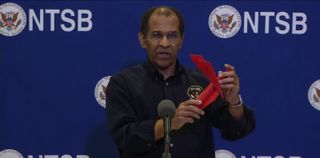
Virgin Galactic's SpaceShipTwo space plane broke apart just after its "feathering" re-entry system deployed early during a tragic test flight on Friday (Oct. 31) that left one pilot dead and another injured, according to the National Transportation Safety Board.
SpaceShipTwo's twin rudders can be "feathered," or rotated up, to increase drag and stability when the vehicle heads back down toward Earth. During Friday's SpaceShipTwo crash, this maneuver should have been performed when the suborbital space plane was traveling at Mach 1.4 (1.4 times the speed of sound), but it actually happened at Mach 1.0, NTSB Acting Chairman Christopher Hart said late Sunday (Nov. 2).
"The feathers moved into the deploy position, and two seconds later, we saw disintegration," Hart said during a news conference. [Virgin Galactic's SpaceShipTwo Crash: Full Coverage]
This news about the feather system is "a statement of fact and not a statement of cause," Hart said. "We are a long way from finding cause. We still have months and months of investigation to do."

The NTSB is leading the investigation into the crash, which killed SpaceShipTwo co-pilot Michael Alsbury and sent pilot Peter Siebold to the hospital. An NTSB "Go-Team" arrived in Mojave, California on Saturday morning (Nov. 1) to begin this work. SpaceShipTwo took off from Mojave Air and Space Port under the wing of its carrier plane WhiteKnightTwo to carry out Friday's ill-fated test flight.
Hart said that the NTSB team located SpaceShipTwo's fuel tanks and engine, which showed no signs of an in-flight explosion.
"The fuel tanks were found intact, with no indication of breach or burn-through, and so was the engine as well," Hart said.
Get the Space.com Newsletter
Breaking space news, the latest updates on rocket launches, skywatching events and more!
Two things need to happen for SpaceShipTwo's feather system to be commanded by the spacecraft's pilots, Hart said: A lever must be moved to the "unlock" position, and a handle must be moved to the "feather" position.
The first of these actions was performed on Friday — video taken from inside the cockpit shows the co-pilot moving the lever — but the second action with the handle was not performed, Hart said, describing the maneuver as "an uncommanded feather." It took place 9 seconds after SpaceShipTwo's rocket engine kicked on.
SpaceShipTwo is designed to be carried to an altitude of about 50,000 feet (15,000 meters) by WhiteKnightTwo. At this point, the six-passenger space plane is dropped, and its rocket engine turns on, launching SpaceShipTwo up into suborbital space. About 700 people have put down deposits for such a ride, which currently costs $250,000.
That's how things will work when the vehicle is fully up and running. But for now, SpaceShipTwo remains in the test phase; Friday's mission was its fourth rocket-powered test flight, and its 55th test flight of any kind.
Virgin Galactic issued a new statement Sunday stressing its commitment to safe operations.
"At Virgin Galactic, we are dedicated to opening the space frontier, while keeping safety as our 'North Star.' This has guided every decision we have made over the past decade, and any suggestion to the contrary is categorically untrue, " Virgin Galactic representatives wrote.
"We have the privilege to work with some of the best minds in the space industry, who have dedicated their lives to the development of technologies to enable the continued exploration of space," they added. "All of us at Virgin Galactic understand the importance of our mission and the significance of creating the first-ever commercial spaceline. This is not a mission that anyone takes lightly."
Follow Mike Wall on Twitter @michaeldwall and Google+. Follow us @Spacedotcom, Facebook or Google+. Originally published on Space.com.
Join our Space Forums to keep talking space on the latest missions, night sky and more! And if you have a news tip, correction or comment, let us know at: community@space.com.

Michael Wall is a Senior Space Writer with Space.com and joined the team in 2010. He primarily covers exoplanets, spaceflight and military space, but has been known to dabble in the space art beat. His book about the search for alien life, "Out There," was published on Nov. 13, 2018. Before becoming a science writer, Michael worked as a herpetologist and wildlife biologist. He has a Ph.D. in evolutionary biology from the University of Sydney, Australia, a bachelor's degree from the University of Arizona, and a graduate certificate in science writing from the University of California, Santa Cruz. To find out what his latest project is, you can follow Michael on Twitter.
